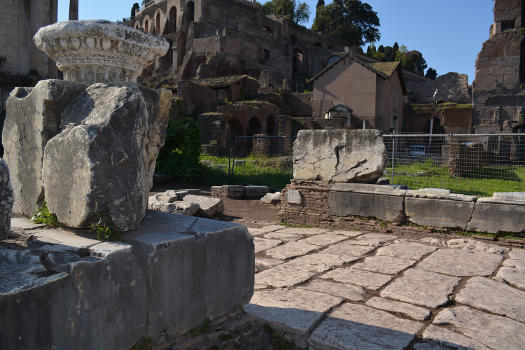General Information
| Name in local language: | Arco di Augusto |
|---|---|
| Completion: | 1st century B.C. |
| Status: | demolished |
Project Type
| Structure: |
Arch |
|---|---|
| Function / usage: |
Triumphal / monumental arch |
| Architectural style: |
Roman |
| Material: |
Masonry structure |
Location
Technical Information
Dimensions
| number of arches | 3 |
Materials
| arches |
stone
|
|---|
Notes
Only the foundations remain of the triumphal arch. They can still be seen in the Forum Romanum.
Excerpt from Wikipedia
The Arch of Augustus (Italian:Arco di Augusto) was the triumphal arch of Augustus, located in the Roman Forum. It spanned the Via Sacra, between the Temple of Castor and Pollux and the Temple of Caesar, near the Temple of Vesta, closing off the eastern end of the Forum. It can be regarded as the first permanent three-bayed arch ever built in Rome.
The archaeological evidence shows the existence of a three-bayed arch measuring 17,75 x 5.25 meters between the Temple of Caesar and the Temple of Castor and Pollux, although only the travertine foundations of the structure remain.
Ancient sources mention arches erected in honor of Augustus in the Forum in two different occasions: the victory over Antony and Cleopatra in 31 BCE, and the recovery of the standards lost to the Parthians in 20 BCE.
Actian Arch
Denarius with one-bayed Augustan arch, probably struck in Rome in ca. 30-29 BCE.
Cassius Dio reports that after the Battle of Actium the Senate granted Augustus a triumph and an arch in an unspecified spot in the Forum.
No description of the structure remains, although it is possible that the Actian Arch is represented on a coin minted in ca. 30-29 BCE. However, the arch depicted on the coin could also refer to another instance in which Augustus was granted a triumphal arch after the victory over Sextus Pompey in 36 BCE.
A marble slab long 2.65 m. long and 0.59 m high bearing an inscription in honor of Augustus as savior and keeper of the Republic discovered in 1546 and subsequently lost was attributed to the Actian Arch.
Parthian Arch
Cassius Dio mentions an ovatio and another triumphal arch granted to Augustus after he recovered the eagles lost in the battles of Carrhae and during Antony's campaign in Atropatene without specifying its location. A Veronese scholiast commenting on Vergil's Aeneid situates the structure next to the Temple of Caesar.
The arch is not mentioned by Augustus in his autobiography; moreover, Suetonius and Cassiodorus report that he refused to celebrate a triumph in 19 BCE, leading some scholars to believe that the Parthian Arch might have been projected but never realized.
Denarius with three-bayed arch, struck in Tarraco in 18 BCE.
Coins minted in Pergamon, Tarraco, and Rome in the years 19-16 BCE show a three-bayed arch with a quadriga on the top and figures holding bows and standards on the lower bays. Accordingly, the proposed reconstructions display a structure consisting of a higher central vaulted bay with Corinthian semi-columns and a triumphal chariot on top. The lower bays had square-topped pediments with Doric columns or semi-columns surmounted by statues of Parthians holding bows and the recovered eagles.
The Fasti Consulares and the Fasti Triumphales, unearthed in the Forum in 1546, may have been originally part of this monument, standing in the lateral aediculae; alternatively, they may have belonged to the nearby Regia.
Text imported from Wikipedia article "Arch of Augustus, Rome" and modified on July 22, 2019 according to the CC-BY-SA 4.0 International license.
Participants
Currently there is no information available about persons or companies having participated in this project.
Relevant Web Sites
Relevant Publications
- (2016): The Arch of Augustus in Rimini: The internal structure determined with a special tomography. Presented at: Structural Analysis of Historical Constructions (SAHC) 2016, Leuven, Belgium, 13-15 September 2016.
- (2000): The triple arch of Augustus and the Roman triumph. In: Journal of Roman Archeology, v. 13, n. 1 ( 2000), pp. 183-191.
- About this
data sheet - Structure-ID
20003243 - Published on:
13/05/2002 - Last updated on:
07/05/2024






